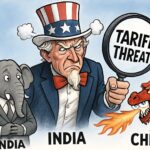India’s foreign policy is at a crossroads, and Parliament knows it. In a pointed observation tabled in Parliament this week, the Standing Committee on External Affairs, chaired by Shashi Tharoor, issued a renewed and urgent call for the formulation of a Strategic Foreign Policy Doctrine Document — a formalized grand strategy that India conspicuously lacks.
The call is not new. But what makes it more pressing now is the context: a fast-fracturing global order, intensifying geopolitical competition, rising regional uncertainty, and a deeply transactional era in international diplomacy. In such a climate, India’s persistent refusal — or institutional inability — to codify a long-term foreign policy vision is no longer defensible.
While the Ministry of External Affairs (MEA) insists that India’s foreign policy is guided by time-tested principles — sovereignty, strategic autonomy, peaceful coexistence, national interest — the committee’s report lays bare a deeper truth: India’s diplomacy lacks strategic clarity, institutional continuity, and publicly articulated long-term goals.
As Tharoor’s panel rightly points out, the MEA has yet to produce a consolidated, forward-looking doctrine to help India navigate global uncertainties and communicate its strategic intent. Countries like the United States, China, Japan, and even the European Union regularly publish national security and foreign policy strategy documents. These are not just bureaucratic exercises — they are tools of statecraft, signaling intentions to allies, deterrence to adversaries, and reassurance to citizens.
India, in contrast, continues to operate in a reactive, improvisational mode, shifting gears from crisis to crisis — whether it’s managing tensions with China, recalibrating trade relations with the US, or reasserting its position in the Global South. The absence of a doctrinal framework risks turning Indian diplomacy into an exercise in tactical juggling rather than strategic positioning.
The MEA’s response to the committee is telling. It claims that while there is no single overarching document, its foreign policy is grounded in enduring principles, pragmatism, and responsiveness. It further argues that India’s diplomatic positions are articulated across various platforms.
But that, critics argue, is precisely the problem: articulation without consolidation, principles without prioritization, and practice without codification. These diffuse signals may have served India in the past, when non-alignment and moral leadership sufficed, but the 21st-century world demands strategic coherence and communicable intent.
India aspires to be a leading power. But leadership in international affairs is not measured by GDP rankings or summit photo-ops alone — it is equally about projecting predictability, purpose, and policy foresight.
Why a Doctrine Matters Now
- Without a formal doctrine, India’s foreign policy goals remain vulnerable to several risks:
- Strategic Drift – In the absence of long-term objectives, India’s foreign engagements are susceptible to shifting political winds and individual leadership styles, rather than institutional vision.
- Misperception by Allies and Adversaries – Nations, particularly in South Asia and the Indo-Pacific, often find India’s positions ambiguous. This creates space for opportunistic actors — notably China — to influence the regional narrative.
- Lack of Inter-agency Coordination – A formal doctrine would enable whole-of-government alignment, harmonizing diplomacy, trade, defense, and technology policies into a coherent external agenda.
- Failure to Build Domestic Consensus – Foreign policy is not the exclusive preserve of the executive. A strategic doctrine, debated in Parliament and shaped by experts, can help build bipartisan ownership — vital for policy continuity across governments.
- Missed Soft Power Potential – India champions democracy, pluralism, and development. But without a doctrinal framework, these values remain slogans rather than strategic assets.
What Needs to Be Done
The path forward is clear, but politically inconvenient. The Ministry of External Affairs must move beyond bureaucratic resistance and institutional inertia. It must initiate a structured consultative process involving:
- Strategic affairs experts, both domestic and international
- Former diplomats and intelligence officials with operational experience
- Parliamentary committees, to ensure democratic legitimacy
- Think tanks and academia, for critical external perspectives
- Defense, trade, and technology ministries, for integrated vision
This process should aim to produce a non-classified Strategic Foreign Policy Doctrine Document, similar in spirit to the US National Security Strategy or China’s White Papers, with regular updates and public availability.
Such a document must outline:
- India’s core national interests
- Its strategic priorities by region (South Asia, Indo-Pacific, West Asia, Africa, Europe)
- The tools of statecraft India will prioritize — soft power, military diplomacy, trade, tech alliances
- A clear approach to multilateralism and institutional reforms
- Its stance on critical issues like digital governance, climate diplomacy, and supply chain security
Conclusion: India Cannot Afford Strategic Ambiguity
India is no longer a marginal player in the international system. Its ambitions — from securing a permanent UNSC seat to shaping global norms — require more than instinct and improvisation. They demand a codified, long-term doctrine rooted in clarity, transparency, and realism.
The Tharoor-led committee’s call is a reminder that global leadership is not just about asserting interests, but also about articulating purpose. India’s time to do that — formally and forcefully — is now.






